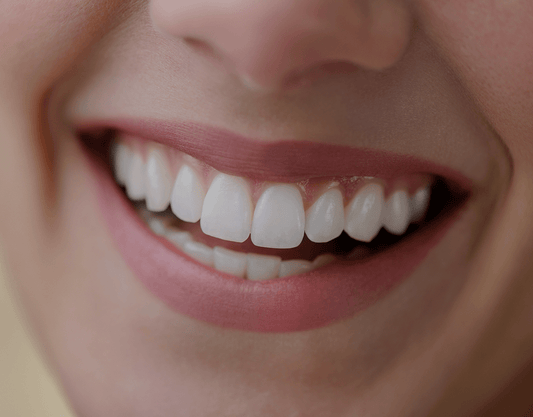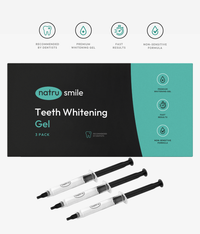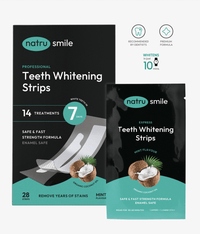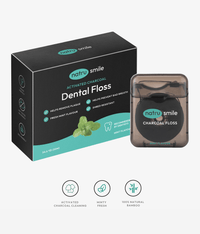
All products are certified by dental expert Dr. Greg Grillo
Just like dogs, humans have a set of four canine teeth – two on the top and two on the bottom. These teeth are located between your incisors (front teeth) and premolars (back teeth). Canine teeth are so-called for their resemblance to fangs, and they are often nicknamed "eye teeth" due to being positioned directly beneath the eyes.
We use our canine teeth for foods that require biting and tearing, such as steak or raw vegetables. They are also used for biting into hard foods, like apples or carrots. Human canine teeth are important for proper chewing and digestion of food, so it is essential that we keep them healthy.
In this article, we will explore the anatomy of our human canine teeth and discuss how to best care for them in 2023. Read on to learn more!
Why Is It Called A Canine Tooth?
The word 'canine' refers to dogs and dog-related things; for instance, 'canine behavior' is behavior that is typical of dogs. Human canine teeth are so named due to their resemblance to the fangs of a dog, which are more pronounced and pointed than our own.
Human canine teeth have two distinct parts: the crown and the root. The crown is the visible part of your tooth – it's what you see when you open your mouth. It has an oval shape with pointed edges at the top, similar to a cone or pyramid shape. The root is underneath the gums and not visible; it serves as an anchor for the tooth in your jawbone.
The canine tooth is positioned not next to your buck teeth, but in the middle of four teeth on either side. It is usually shaped differently from its neighbors, as it has pointed edges and a conical shape that helps it grip food better.
Why Do Humans Have Canine Teeth?
You may be wondering – if we don't need to fight and hunt like dogs or other fanged animals, why have we evolved a set of four canines? It turns out that our canine teeth are essential for proper chewing and digestion of food, and they were even more crucial in our evolutionary past.
Human beings are a part of the hominin family, which is now millions of years old. The Neanderthals were hominins, as were the Australopithecines, Homo Erectus, and other species in our ancient family. Humans are the only remaining hominin species; our canine teeth closely resemble those of our ancestors.
Hominins evolved from a common ancestor shared with bonobos and chimpanzees. We branched off around seven million years ago, gradually becoming bipedal and developing larger brains and specialized teeth. Our canine teeth reduced in size over millions of years.
The common assumption is often that we evolved these teeth in order to chew food more effectively – but this is not necessarily the case. Our primate ancestors had canines reaching down to their bottom jaw, which they used to fight with one another and establish dominance. We no longer need to use them for this purpose, but they still help us to tear and bite into food.
The Function Of Your Canine Teeth
Canine teeth in humans are there for the same purpose as most other teeth: to adequately break down food for digestion. Humans use their canines to tear and grip tougher foods, such as fruits, vegetables, and meats. We also use our canine teeth to guide food into the best position for biting down.
As well as helping to eat, canines work with the incisors to make certain sounds when speaking. Human canine teeth are used for aesthetic purposes in some cases, too. Many cultures around the world have practiced sharpening their canines throughout history to make them more noticeable or intimidating looking. This practice is still seen today in many places, but it is not recommended due to potential health risks.
Canine Teeth And Gum Recession
Gum recession is also known as gingival recession or orthodontic movement. It refers to a condition in which teeth have become exposed due to the loss of gum tissue. This exposes dental roots, leading to sensitive teeth and an increased risk of cavities and periodontal disease.
Gum recession can be caused by various factors, including:
- Poor oral hygiene. A buildup of plaque and tartar can lead to gum disease, causing the tissue to pull away from the teeth.
- Incorrect brushing technique. Brushing too hard or using a toothbrush with hard bristles damages the gums and causes them to recede.
- Periodontal disease. This disease is the result of a bacterial infection in the gums and can lead to gum recession.
Since canines tend to have longer roots and more exposure than other teeth, there is a greater risk of bacterial buildup and therefore gum recession. It is important to practice good oral hygiene and visit the dentist regularly to ensure that your canines are healthy and free from gum disease.
How To Get Rid Of Pointy Canine Teeth
There are a number of reasons why someone may choose to reshape their canines to remove the sharp point. Perhaps they are too sharp and cause frequent gum injuries; it may also be an aesthetic concern, as some people don't like the look of long, sharp canines. Let's take a look at some of the ways you can reduce your canine teeth.
Dental Bonding
The process of dental bonding is used for many cosmetic purposes, including recoloring yellowed or blotched teeth and reshaping canines. It involves adding a tooth-colored resin to the canines, which is then hardened with a special light. The process follows a series of steps:
- The dentist finds a matching resin color shade for the teeth being treated.
- The surface of each canine is roughened gently to help the resin adhere.
- A special conditioning solution is spread over the teeth.
- The resin is applied, shaped, and hardened with a special light.
- Finally, the bonded teeth are polished to give them a natural look.
This non-intrusive procedure is often preferred for reshaping canines, as it doesn't require any cutting or filing of the teeth.
Tooth Reshaping
Odontoplasty, or tooth reshaping, is a procedure that removes small amounts of enamel from the tooth to alter its shape. It can be used to reshape canines and correct minor misalignments. Since canine alterations are usually minor and take place right at the end of the tooth, reshaping them is considered a safe and effective method.
The process begins with an initial consultation to discuss what you would like your canines to look like. Then, the dentist will use special tools to carefully remove small amounts of enamel from the teeth until they have reached the desired shape. After that, he or she may recommend additional treatments such as contouring or bonding for a more natural look.
Dental Veneers
Dental veneers are another effective way to reshape canines and improve your smile. They are thin pieces of porcelain that are bonded to the surface of the teeth, instantly transforming their appearance. Porcelain veneers can be used to cover discolored or misshapen canine teeth, giving them a more uniform and aesthetically pleasing look.
After an initial consultation, the dentist will take an impression of your teeth and then create a veneer for each canine. The veneers are bonded to the tooth surface with special dental glue and then polished for a perfect finish. The only issue with veneers is that they may stand out at first compared to your other teeth, but a simple whitening treatment can help to even out the color.
Tooth Recontouring
Often confused with tooth reshaping, recontouring is a very similar process of changing the tooth's shape – however, this procedure is restricted to just the enamel layer of the tooth. This is much less invasive but the results aren't as drastic as with reshaping. The process involves filing down the tooth to even out any imperfections or sharp points, giving your canines a more balanced and uniform look.
The Takeaway
Human canine teeth are one of the most important features of our smiles and need to be taken care of. While it is normal for them to have a sharp point, some people may choose to reshape their canines if they are too long or sharp. There are several ways to do this, including dental bonding, tooth reshaping, veneers, and recontouring.
It's important to visit your dentist regularly in order to make sure your canines are in good health, and if you do decide to reshape them, make sure it is done by a qualified professional. With the right care and maintenance, you can have beautiful canines that will help give you the perfect smile.
Now that you're up to speed with the purpose of human canines, here are a few commonly asked questions about them:
Are Human Canine Teeth Supposed To Be Pointy?
Yes. Human canines are pointy which helps for chewing tough food; however, that isn't the reason why they became pointy in the first place. The evolutionary reason is that our ancestors from millions and millions of years ago used them for defense and competing with others over mates. Now, our canines are much smaller than they once were – but not without their uses.
How Rare Is It To Have Canine Teeth?
Every human is born with canine teeth unless there is an underlying medical condition. The only difference between people is the size, shape, and color of their canines – but all in all, having them is perfectly normal. We each have four canines, with two on the top and two on the bottom. They are often called 'eye teeth' due to their position directly down from the eyes.
Is It Ok To Remove Canine Teeth?
Since canine teeth are integral to human facial anatomy, dentists will not typically remove them unless absolutely necessary. This is usually done in cases where the teeth are severely damaged, cracked, or infected and cannot be saved. If you are considering having your canine teeth removed for aesthetic reasons, it's best to discuss this with your dentist first in order to determine if it's a safe option.
Why Are Canine Teeth Important?
Canines are important for both aesthetic and functional reasons. Aesthetically, they help to give our smile a balanced look and shape. Functionally, they play an integral role in helping us to chew tough food properly and break it down into smaller pieces before we swallow. Without them, the process of eating would be much more difficult than it already is!
Do All Humans Have Canines?
Human sharp front teeth are called canines or cuspids. While it might be strange to think of humans with canine teeth, they are much less fang-like than those found in other animals. All humans have canine teeth, but they come in different sizes and shapes depending on the person. Large canine teeth are often the cause of pain or insecurity, so some people get theirs reshaped.
Do Canine Teeth Grow Back?
Canine teeth are similar to other teeth in that they will grow back after the first set of baby teeth, but not if they are removed for a second time. If a canine tooth needs to be removed due to an underlying medical condition, it will not grow back. This is why it's so important to take care of your teeth and see the dentist regularly – to avoid any major issues from arising in the future. Always consult with your dentist before making any major dental decisions.
Is Canine Tooth Extraction Painful?
It is normal to feel some discomfort during and after the extraction of a canine tooth. Your dentist will use an anesthetic to minimize any pain and make sure that you remain comfortable throughout the entire process. After the procedure, you may also experience some swelling, bleeding, or bruising around the site of extraction; all of which can be managed with over-the-counter pain medications.
What Do Your Canine Teeth Say About You?
Your canine teeth can say a lot about you. The shape, size, and color of your canines are all unique to each individual person – so they help give others a glimpse into who you are as a person. Some people believe that sharper canines indicate a bold and assertive nature, while those with more rounded canines might be seen as more gentle and kind. Ultimately, it's up to you to decide what your canines say about you!
How Long Does A Canine Tooth Extraction Take?
The time it takes to extract a canine tooth will depend on the complexity of the case. A simple extraction can take anywhere from 10-15 minutes, while more complicated cases may require up to an hour or longer for completion. Your dentist will discuss with you ahead of time what to expect during the procedure and how long it should take.
How Long Does It Take For A Canine Tooth Extraction To Heal?
The healing time for a canine tooth extraction will vary depending on your individual situation. Generally speaking, it can take anywhere from one to four weeks to heal completely, although some people may experience longer healing times. During this period, it's important to follow any instructions given by your dentist in order to promote the fastest possible recovery and avoid infection.
Can A Canine Tooth Be Replaced After Extraction?
Dental implants are the most common way to replace a canine tooth after extraction. A titanium post is surgically placed in the jawbone and then a crown or bridge is attached on top of it. This method requires multiple visits to the dentist before it’s completed, but is highly effective at restoring your smile back to its original form.










